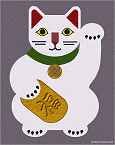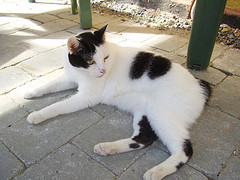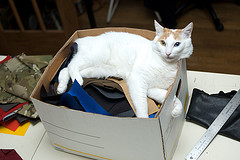|
The Japanese Bobtail cat, a living lucky charmColorThe CFA accepts the Japanese Bobtail cat in a variety of colors and patterns including solids, bi-colors and tabbies. However, the most popular at shows are the same as those seen in ancient Japanese art, the showy spotted bi-colors or calicos. GroomingWhile shorthaired Japanese Bobtails require almost no grooming other than petting, longhaired Japanese Bobtails may benefit from an occasional brushing, if only to keep the ruff and leg britches looking nice and fluffy. This breed does not shed excessively, and what little shedding does occur is usually in the spring. PersonalityThis playful, gregarious cat needs to have a lot of interaction, either from humans or from another pet. These cats want to be involved in absolutely everything. They have a calm demeanor and will shower their love on friends and family alike. Never a yowler, the Japanese Bobtail tends to communicate with little humming or chirping sounds in addition to its sweet toned voice saying “meow”. A natural at jumping and retrieving, Japanese Bobtails love to play tag or a good game of fetch. AppearanceThis is a medium-sized breed, generally lean and muscular. The Japanese Bobtail's legs are long and slender with the hind legs being noticably taller. True to its name, this cat is partially tailed. The bobtail may have curves, angles and/or kinks, but for show the tail must not be more than 3 inches long. Their tail is movable at the base and is very expressive. Big slanted eyes (odd eyes are not uncommon) and high set cheekbones complete the lovely picture presented by this ancient Oriental breed. The coat can be short or semi-long. The semi-longhaired cats will have britches and a neck ruff.
The Japanese Bobtail as a CompanionThis ancient breed has come a long way, and is now a favorite all around the globe. Active, calm and undaunted by chaos and noisy situations, the Japanese Bobtail makes an ideal pet for a busy family household, especially when kept with other pets. Breeders recommend that Japanese Bobtails always have an animal companion of some sort, be it cat, dog or other. If kept alone, this cat may well get into mischief. A terrific, friendly personality plus a spirited and fearless approach to life make this breed is among the liveliest and most interesting to have in the home.

Send Maneki Neko e-cards and read the legend here!
Back from Japanese Bobtail cat to Cat Breeds
|








